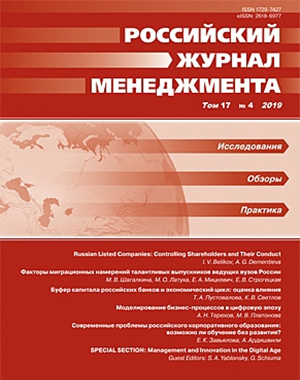Факторы миграционных намерений талантливых выпускников ведущих вузов России
DOI:
https://doi.org/10.21638/spbu18.2019.402Аннотация
Миграция высококвалифицированных кадров из России, в том числе и выпускников российских вузов, продолжает возрастать, ставя под угрозу возможность устойчивого развития страны вследствие утечки человеческого капитала. В статье обсуждаются причины миграции талантливых выпускников и анализируются факторы, влияющие на их миграционные намерения. Исследование, проведенное с использованием логистической регрессионной модели, выявило, что характеристики отрасли, а также факторы, которые характеризуют восприятие выпускниками политической, социальной и экономической свободы и равенства в стране, близость с семьей, международный опыт и способность адаптации к культурам, оказывают воздействие на формирование миграционных намерений. Определена потенциальная роль бизнеса в решении проблемы утечки человеческого капитала. В частности, показано, что применение практик управления талантливыми сотрудниками может выступать в качестве механизма удержания талантливых выпускников вузов в стране.
Ключевые слова:
утечка умов, человеческий капитал, выпускники, высококвалифицированные специалисты, миграция, факторы миграции, страны с растущей экономикой, Россия
Скачивания
Библиографические ссылки
REFERENCES IN LATIN ALPHABET
Translation of references in Russian into English
Загрузки
Опубликован
Как цитировать
Выпуск
Раздел
Лицензия
Статьи журнала «Российский журнал менеджмента» находятся в открытом доступе и распространяются в соответствии с условиями Лицензионного Договора с Санкт-Петербургским государственным университетом, который бесплатно предоставляет авторам неограниченное распространение и самостоятельное архивирование.





